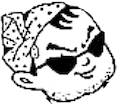

ダンソン
Danzón
Basic
baqueteo timbales part.
☆ ダンソン(Danzón) はキューバの公式な音楽ジャンルであり、ダンスである[1]。2 4拍子で書かれたダンソンは、ゆったりとした正式なパートナーダンスであり、シンコペーションのビートを中心に決まったフットワークが要求され、チャラン ガやティピカ・アンサンブルによって特徴的に演奏される名人芸的な楽器のパッセージに耳を傾けながらカップルが立っている間、優雅なポーズが組み込まれる [2]。 ダンソンはキューバのコントラバンザ(ハバネラ)(「ハバナダンス」)から発展した。英語とフランス語のカントリーダンスとコントレダンスをルーツとする コントレダンサは、キューバをほぼ4世紀(1511年~1898年)にわたって支配したスペイン人によってキューバに伝えられ、何千人もの移民をもたらし たと思われる。また、1762年にイギリスがハバナを短期間占領した際にも、部分的に種が蒔かれた可能性がある。1791年から1804年にかけての島の 革命を逃れてきたハイチ難民が、フランス系ハイチ人のコントルダンスを持ち込み、彼ら独自のクレオール・シンコペーションをもたらした。 [3][4]キューバでは、ヨーロッパ発祥のダンスがアフリカのリズムやダンスに由来する新たな様式的特徴を獲得し、ヨーロッパとアフリカの影響の真の融 合を生み出した[5]。ダンソンのアフリカ音楽の特徴には、千鳥のチンキージョやトレシージョのパターンで表現される複雑な楽器の交差リズムが含まれる [2]。 1879年、ミゲル・ファイルデの「シンプソンの高度(Las alturas de Simpson)」が(マタンサスで)初演されるまでに[2]、ダンソンは独自のジャンルとして確立した。ダンソンはソンなどの20世紀キューバのジャン ルと交流し、ダンソンマンボを通してマンボやチャチャチャの発展に貢献した。
| Danzón is the
official musical genre and dance of Cuba.[1] It is also an active
musical form in Mexico and Puerto Rico. Written in 2 4 time, the danzón is a slow, formal partner dance, requiring set footwork around syncopated beats, and incorporating elegant pauses while the couples stand listening to virtuoso instrumental passages, as characteristically played by a charanga or típica ensemble.[2] The danzón evolved from the Cuban contradanza, or habanera ('Havana-dance'). The contradanza, which had English and French roots in the country dance and contredanse, was probably introduced to Cuba by the Spanish, who ruled the island for almost four centuries (1511–1898), contributing many thousands of immigrants. It may also have been partially seeded during the short-lived British occupation of Havana in 1762, and Haitian refugees fleeing the island's revolution of 1791–1804 brought the French-Haitian kontradans, contributing their own Creole syncopation.[3][4] In Cuba, the dances of European origin acquired new stylistic features derived from African rhythm and dance to produce a genuine fusion of European and African influences.[5] African musical traits in the danzón include complex instrumental cross-rhythms, expressed in staggered cinquillo and tresillo patterns.[2] By 1879, the year Miguel Failde's Las alturas de Simpson was first performed (in Matanzas),[2] danzón had emerged as a distinct genre. Danzón went on to interact with 20th century Cuban genres such as son, and through the danzón-mambo it was instrumental in the development of mambo and cha-cha-chá. |
ダンソンはキューバの公式な音楽ジャンルであり、ダンスである[1]。
2 4拍子で書かれたダンソンは、ゆったりとした正式なパートナーダンスであり、シンコペーションのビートを中心に決まったフットワークが要求され、チャラン ガやティピカ・アンサンブルによって特徴的に演奏される名人芸的な楽器のパッセージに耳を傾けながらカップルが立っている間、優雅なポーズが組み込まれる [2]。 ダンソンはキューバのコントラバンザ(ハバネラ)(「ハバナダンス」)から発展した。英語とフランス語のカントリーダンスとコントレダンスをルーツとする コントレダンサは、キューバをほぼ4世紀(1511年~1898年)にわたって支配したスペイン人によってキューバに伝えられ、何千人もの移民をもたらし たと思われる。また、1762年にイギリスがハバナを短期間占領した際にも、部分的に種が蒔かれた可能性がある。1791年から1804年にかけての島の 革命を逃れてきたハイチ難民が、フランス系ハイチ人のコントルダンスを持ち込み、彼ら独自のクレオール・シンコペーションをもたらした。 [3][4]キューバでは、ヨーロッパ発祥のダンスがアフリカのリズムやダンスに由来する新たな様式的特徴を獲得し、ヨーロッパとアフリカの影響の真の融 合を生み出した[5]。ダンソンのアフリカ音楽の特徴には、千鳥のチンキージョやトレシージョのパターンで表現される複雑な楽器の交差リズムが含まれる [2]。 1879年、ミゲル・ファイルデの「シンプソンの高度(Las alturas de Simpson)」が(マタンサスで)初演されるまでに[2]、ダンソンは独自のジャンルとして確立した。ダンソンはソンなどの20世紀キューバのジャン ルと交流し、ダンソンマンボを通してマンボやチャチャチャの発展に貢献した。 |
History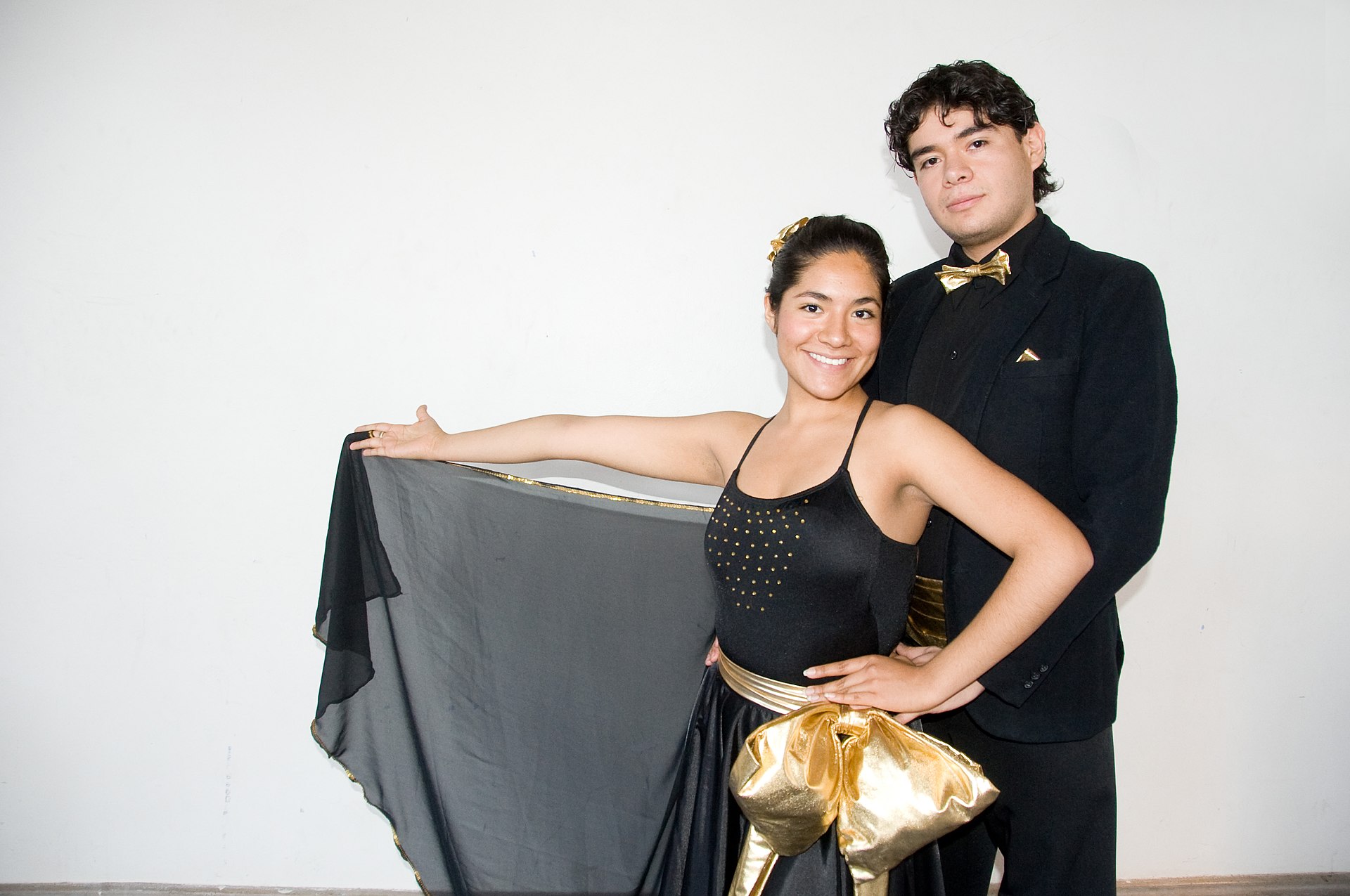 Danzón dancers from Monterrey Institute of Technology and Higher Education, Mexico City The danzón developed from the habanera, a creolized Cuban dance form. By 1879, the year Las alturas de Simpson composed by Miguel Failde (leader of the Orquesta Faílde) was first performed in Matanzas,[2] danzón had emerged as a distinct genre.[4] Creation of the new danzón form is generally attributed to Faílde.[6] The classical composer Manuel Saumell has also been cited as a key figure in its delineation.[7] Precursors: figure dances The English contradanza was the predecessor of the "habanera", also known as danza criolla. Out of this Creole genre, the Habanera, was born in 1879 another Cuban genre, called danzon, a sequence dance, in which all danced together a set of figures.[8] The first use of the term danzón, which dates from the 1850s, is for just such a dance. Havana's daily paper, El Triunfo, gave a description of this earlier danzón. It was a co-ordinated dance of figures performed by groups of Matanzas blacks. The dancers held the ends of colored ribbons, and carried flower-covered arches. The group twisted and entwined the ribbons to make pleasing patterns.[9][10] This account can be corroborated by other references, for example, a traveler in Cuba noted in 1854 that black Cubans "do a kind of wreath dance, in which the whole company took part, amid innumerable artistic entanglements and disentanglements".[11] This style of danzón was performed at carnival comparsas by black groups: it is described that way before the late 1870s.[12] Faílde's first danzóns were created for just such sequence dances. Faílde himself said "In Matanzas at this time there was a kind of square dance for twenty couples who carried arches and flowers. It was really a dance of figures (sequence dance), and its moves were adapted to the tempo of the habanera, which we took over for the danzón."[13] Structure and instruments The form of danzón created by Miguel Faílde in 1879 (Las alturas de Simpson), begins with an introduction (four bars) and paseo (four bars), which are repeated and followed by a 16-bar melody. The introduction and paseo again repeat before a second melody is played. The dancers do not dance during these sections: they choose partners, stroll onto the dance floor, and begin to dance at precisely the same moment: the fourth beat of bar four of the paseo, which has a distinctive percussion pattern that's hard to miss. When the introduction is repeated the dancers stop, chat, flirt, greet their friends, and start again, right on time as the paseo finishes. 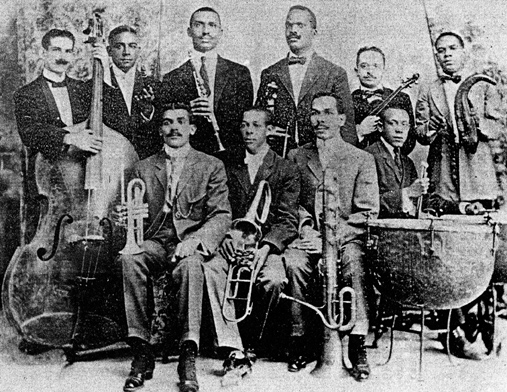 Orquesta Enrique Peña Peña seated left, Barreto (violin) and Urfé (clarinet) Early danzón was played by groups called orquestas típicas, which were based on wind instruments. They had several brass instruments (cornet, valve trombone, ophicleide), a clarinet or two, a violin or two and tympani (kettle drums). At the beginning of the 20th century, the lighter and somewhat more elegant sound of the charanga emerged (see Early Cuban bands). Initially, they were small orchestra of two violins, a cello, flute, timbales, güiro, and doublebass. Charanga and típicas competed with each other for years, but after 1930 it was clear that the days of the típica were over. In 1898, a piano was included in a charanga for the first time. In Antonio María Romeu's hands a piano became standard. Its musical flexibility, its ability to influence both melody and rhythm, made it invaluable. In 1926, in his arrangement of Tres lindas cubanas, Romeu incorporated a piano solo for the first time. His was Cuba's top charanga for many years. Initial perception Similar to other dances in the Caribbean and Latin America, the danzón was initially regarded as scandalous, especially when it began to be danced by all classes of society. The slower rhythm of the danzón led to couples dancing closer, with sinuous movements of the hips and a lower centre of gravity. The author of a survey of prostitution in Havana devoted a whole chapter to the iniquities of dancing, and the danzón in particular.[14] Articles in newspapers and periodicals took up the theme: "Because I love my country, it hurts me to see danzón at gatherings of decent people."[15] "We recommend banning the danza and danzón because they are vestiges of Africa and should be replaced by essentially European dances such as the quadrille and rigadoon."[16] Apparently, the danzón, which later became an insipid dance for older couples, was at first danced with "obscene movements" of the hips by young couples in close embrace, with bodies touching, and by couples who might come from different races... "First we had the danza, then came the danzón... next it will be the rumba, and finally we'll all end up dancing ñáñigo!"[17] So, behind the concern about music and dance were concerns about sexual licence, and about miscegenation, the mixing of races. As with other similar cases, the criticism was to no avail. The danzón became hugely popular, and was the dominant popular music in Cuba until the advent of the son in the 1920s. At length the Cuban government made Faílde the official inventor of the danzón – but not until 1960, by which time the danzón had become a relic, and its 'child', the chachachá, had taken over.[18] Influence of son In 1910, some 30 years after Faílde's early days, José Urfé added a montuno as a final part of his El Bombín de Barretto.[1] This was a swinging section, consisting of a repeated musical phrase, which introduced something of the son into the danzón (a tactic which was to recur again). Because of the popularity of son in the 1920s and 1930s, Aniceto Díaz in Rompiendo la rutina in 1929 added a vocal part, thereby creating a new genre called the danzonete. 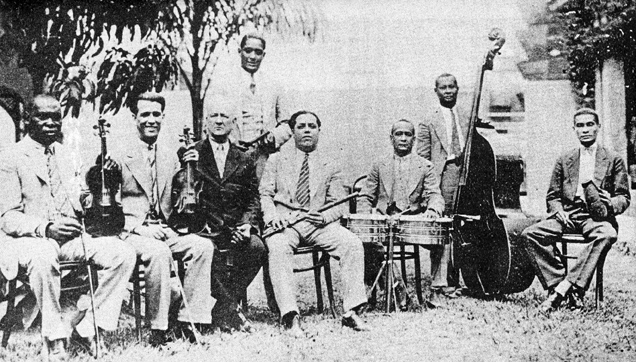 Orquesta Romeu with singer Fernando Collazo, end-1920s Later development led to more syncopation, which eventually led to the danzón-chá, nuevo ritmo, cha-cha-chá, pachanga and mambo. From the 1940s to the 1960s danzón and its derivatives were highly popular in Cuba, with several truly fine charangas playing most days of the week. Orquesta Aragón kept up an exceptionally high standard for many years, but the danzón itself gradually dropped out, and is now a relic dance. Danzón has never ceased to influence Cuban musicians, and it is reflected in many popular Cuban music genres, in Cuban Latin jazz, salsa, songo and timba, the latter building upon the charanga orchestration. Groups like Los Van Van and Orquesta Revé developed from charangas. Their make-up and orchestration (by Juan Formell) has been so greatly altered that it is difficult to identify traces of danzón; indeed, their present styles owe more to son than to danzón. The addition of brass instruments such as trombones and trumpets, and conga drums signalled a wider range of music. |
歴史 メキシコシティ、モンテレイ工科高等教育学校のダンソンのダンサーたち ダンソンは、クレオール化したキューバ舞踊のハバネラから発展した。ミゲル・ファイルデ(オルケスタ・ファイルデのリーダー)が作曲したLas alturas de Simpsonがマタンサスで初演された1879年までに[2]、ダンソンは独自のジャンルとして確立された[4]。 新しいダンソンの創始者は一般的にファイルデとされている[6]。 前身:フィギュア・ダンス イギリスのコントラダンツァは、クリオーリャの踊りとして知られる「ハバネラ」の前身である。このクレオールのジャンルであるハバネラから、1879年に ダンソンと呼ばれるキューバの別のジャンルが生まれた。ダンソンという言葉は1850年代に初めて使われたもので、まさにこのような踊りを指している [8]。ハバナの日刊紙『エル・トリウンフォ』には、この初期のダンソンについての記述がある。それは、マタンサス黒人のグループによって踊られた、人物 の協調的な踊りであった。踊り手は色のついたリボンの端を持ち、花で覆われたアーチを担いだ。例えば、1854年にキューバを訪れたある旅行者は、キュー バの黒人たちが「無数の芸術的な絡み合いと絡み合いの中で、一種の花輪のような踊りを踊り、全員がそれに参加した」と記している[11]。このスタイルの ダンスは黒人グループによってカーニバルのコンパルサで踊られたもので、1870年代後半以前にはそのように記述されている[12]。 フェイルデの最初のダンソンは、まさにそのようなシークエンス・ダンスのために創作された。当時マタンサスでは、20組のカップルがアーチと花を持って踊 るスクエアダンスのようなものがあった。その動きはハバネラのテンポに合わせたもので、私たちはそれをダンソンのために引き継いだ」[13]。 構造と楽器 1879年にミゲル・ファエルデによって創作されたダンソンの形式(Las alturas de Simpson)は、序奏(4小節)とパセオ(4小節)で始まり、これが繰り返され、16小節の旋律が続く。序奏とパセオが再び繰り返された後、2つ目の 旋律が演奏される。ダンサーはこれらの部分で踊ることはない。パートナーを選び、ダンスフロアを歩き、正確に同じ瞬間に踊り始める:パセオの4小節目の4 拍目。イントロが繰り返されると、ダンサーたちは立ち止まり、おしゃべりをし、いちゃつき、友人たちに挨拶をし、パセオが終わるタイミングに合わせて再び 踊り始める。  オルケスタ・エンリケ・ペーニャ ペーニャ(左)、バレート(ヴァイオリン)、ウルフェ(クラリネット 初期のダンソンは、管楽器をベースにしたオルケスタ・ティピカスと呼ばれるグループによって演奏されていた。彼らは数種類の金管楽器(コルネット、バル ブ・トロンボーン、オフィクレイド)、クラリネット1~2本、ヴァイオリン1~2本、ティンパニ(ケトル・ドラム)を持っていた。20世紀初頭になると、 チャランガの軽快でややエレガントなサウンドが登場した(初期のキューバ楽団を参照)。当初は、ヴァイオリン2本、チェロ、フルート、ティンバレス、グイ ロ、コントラバスからなる小さなオーケストラだった。チャランガとティピカは何年も競い合ったが、1930年以降、ティピカの時代が終わったことは明らか だった。 1898年、チャランガに初めてピアノが加わった。アントニオ・マリア・ロメウの手によって、ピアノはスタンダードとなった。その音楽的柔軟性、メロ ディーとリズムの両方に影響を与える能力は、ピアノを貴重なものとした。1926年、ロメウはTres lindas cubanasの編曲で、初めてピアノソロを取り入れた。彼のチャランガは、長年キューバのトップ・チャランガであった。 当初の認識 カリブ海やラテンアメリカの他のダンスと同様、ダンソンは当初、スキャンダラスな踊りとみなされていた。ダンソンのリズムが遅いため、カップルは腰をしな やかに動かし、重心を低くして、接近して踊るようになった。ハバナの売春に関する調査の著者は、ダンス、特にダンソンの悪行について一章を割いている [14]: 「私は祖国を愛しているので、まともな人々の集まりでダンソンを見るのは苦痛だ」[15]。 「ダンツァとダンソンはアフリカの名残であり、カドリールやリガドーンといった本質的にヨーロッパ的な踊りに取って代わられるべきだからだ」[16]。 ダンソンは、後に年配のカップルのための退屈な踊りとなったが、当初は、若いカップルが体を密着させて抱き合ったり、体を触れ合わせたり、異なる人種のカップルが腰を「卑猥な動き」で踊ったりしていたようだ...。 「最初はダンツァ、次にダンソン......次はルンバ、そして最後はみんなでニャーニャーゴを踊るんだ!」[17]。 つまり、音楽とダンスに対する懸念の背後には、性的嗜好に対する懸念と、人種間の混血に対する懸念があったのである。他の同様の事例と同様、批判は無駄 だった。ダンソンは大流行し、1920年代にソンが登場するまでキューバのポピュラー音楽の主流だった。やがてキューバ政府はフェリデを公式にダンソンの 発明者としたが、それは1960年になってからのことであり、その頃にはダンソンは遺物となり、その「子供」であるチャチャチャが後を継いでいた [18]。 息子の影響 1910年、フェルデの初期から約30年後、ホセ・ウルフェはEl Bombín de Barrettoの最後のパートにモントゥーノを追加した[1]。1920年代から1930年代にかけてのソンの人気のため、1929年の 『Rompiendo la rutina』ではアニセト・ディアスが声楽パートを加え、ダンソネーテという新しいジャンルを生み出した。  オルケスタ・ロメウ 歌手のフェルナンド・コラソと(1920年代末 その後の発展によりシンコペーションが増え、最終的にダンソン・チャ、ヌエボ・リトモ、チャ・チャ・チャ、パチャンガ、マンボが生まれた。1940年代か ら1960年代にかけて、ダンソンとその派生曲はキューバで非常に人気があり、本当に素晴らしいチャランガが何日も演奏していた。オルケスタ・アラゴンは 長年にわたって非常に高い水準を維持していたが、ダンソンそのものは次第に廃れていき、今では遺物のような踊りになってしまった。 ダンソンはキューバのミュージシャンに影響を与え続け、キューバのラテン・ジャズ、サルサ、ソンゴ、ティンバなど、多くのポピュラーなキューバ音楽のジャ ンルに反映されている。ロス・ヴァン・ヴァンやオルケスタ・レヴェのようなグループは、チャランガから発展した。フアン・フォルメルによる)彼らの構成と オーケストレーションは、ダンソンの痕跡を確認するのが難しいほど大きく変化している。トロンボーンやトランペットなどの金管楽器やコンガ・ドラムが加わ り、音楽の幅が広がった。 |
| Mexican Danzón Danzon sound clip 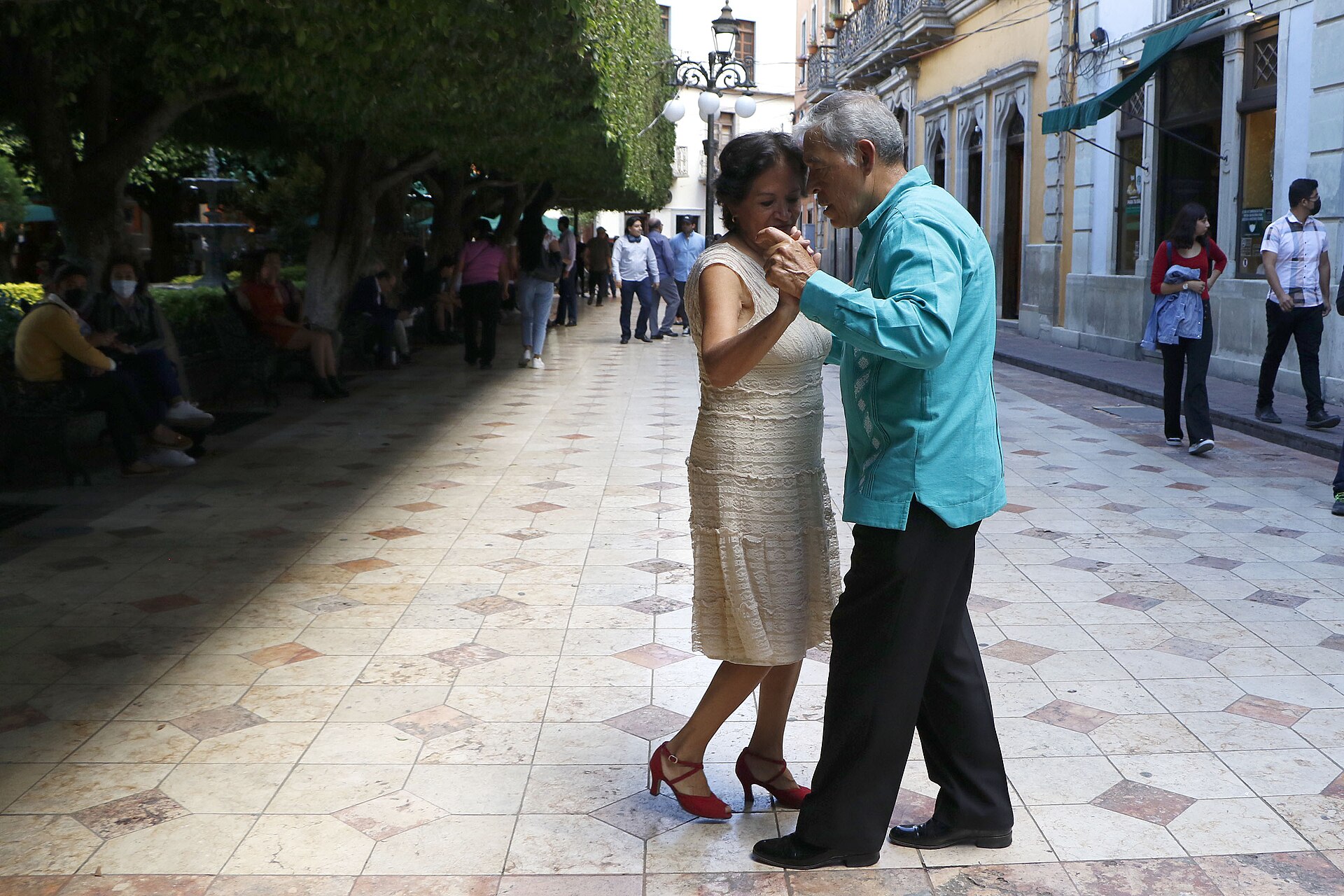 A couple dancing danzón in Guanajuato City, Mexico. Danzón was also very popular in the Gulf Coast state of Veracruz, Mexico, because of the strong Cuban influence in the region. Later on, danzón developed in Mexico City, specially in the famous Salón México; it has survived as a dance longer there than in Cuba. Danzón also flourished in the city of Oaxaca, and many famous danzones were composed by Oaxacan musicians such as the famous Nereidas and Teléfono de larga distancia, both works of Amador Pérez Dimas, from the town of Zaachila, near Oaxaca city. Today, people still dance danzón in Mexico, particularly in the main plazas of Veracruz, Oaxaca and Mexico City, and in yearly festivals across Mexico. The dance had a second revival in the 1990s, especially among Mexico's senior citizens. A film called Danzón was released in 1991 directed by María Novaro. |
メキシコのダンソン ダンソンのサウンドクリップ  メキシコ、グアナフアト市で踊るカップル。 メキシコ湾岸のベラクルス州では、キューバの影響を強く受けていたため、ダンソンは非常に人気があった。その後、ダンソンはメキシコ・シティの有名なサロ ン・メキシコで発展し、キューバよりも長くダンスとして存続した。オアハカ市でもダンスは盛んになり、オアハカ市近郊のサアチラ出身のアマドール・ペレ ス・ディマスが作曲した有名な「Nereidas」や「Teléfono de larga distancia」など、多くの有名なダンスがオアハカ人の音楽家によって作られた。 今日でもメキシコでは、特にベラクルス、オアハカ、メキシコ・シティの主要な広場や、メキシコ全土で毎年開催されるフェスティバルで、人々がダンソンを踊っている。このダンスは1990年代、特にメキシコの高齢者の間で2度目の復活を遂げた。 1991年にはマリア・ノヴァロ監督による映画『Danzón』が公開された。 |
| Concert music Danzón no. 2 by Mexican composer Arturo Márquez (b. 1950) is a popular piece in orchestral concerts. Rhythmic structure  Basic baqueteo timbales part. Playⓘ The basic timbales part for danzón is called the baqueteo. In the example above, the slashed noteheads indicate muted drum strokes, and the regular noteheads indicate open strokes. The güiro also plays this pattern. The danzón was the first written music to be based on the organizing principle of sub-Saharan African rhythm, known in Cuba as clave.[19] |
コンサート音楽 メキシコの作曲家アルトゥーロ・マルケス(1950年生)のダンソン第2番は、オーケストラ・コンサートでよく演奏される曲である。 リズム構成  基本的なバケテオ・ティンバレスのパート。プレイⓘ。 ダンソンの基本的なティンバレス・パートをバケテオと呼ぶ。上の例では、スラッシュされた音頭がミュートされたドラム・ストロークを示し、通常の音頭が オープン・ストロークを示す。グィロもこのパターンを演奏する。ダンソンは、キューバではクラーベとして知られる、サハラ以南のアフリカのリズムの組織原 理に基づいて書かれた最初の音楽である[19]。 |
| Style and form structure Danzón is elegant and virtuoso music, with dance. A danzón, in its original form, was not sung, and did not feature any improvisations, unlike some other Cuban genres. A danzón has the following typical structure: An introduction or paseo (A), usually 16 bars. The theme or principal melody (B), featuring the flute, thus often referred to as parte de (la) flauta. A repeat of the introduction. The trio (C), featuring the strings, thus also called parte del violín. Ending. This could either be a cliché ending (there are a few standard danzón endings), another repeat of the introduction, or a combination of both. The classic form is thus ABAC or ABACA. A danzón-chá or danzón-mambo typically add another part (D), a syncopated open vamp in which soloists may sometimes improvise, creating an ABACD or, more common, ABACAD. |
スタイルと形式構成 ダンソンは、踊りを伴う優雅で名人芸的な音楽である。ダンソンの原形は、他のキューバのジャンルと異なり、歌はなく、即興演奏もない。ダンソンの典型的な構成は以下の通りである: 序奏またはパセオ(A)、通常16小節。 主題または主旋律(B)、フルートがフィーチャーされる。 序奏の繰り返し。 弦楽器をフィーチャーしたトリオ(C)は、parte del violínとも呼ばれる。 エンディング。決まりきった終わり方(いくつかの標準的な終わり方がある)、序奏の繰り返し、またはその両方の組み合わせがある。 古典的な形式はABACまたはABACAである。ダンツォン・チャやダンツォン・マンボでは、もう1つのパート(D)を加えるのが一般的で、シンコペーションのあるオープンヴァンプで、ソリストが即興で演奏することもあり、ABACDか、より一般的なABACADとなる。 |
| Mambo section Main article: mambo section In danzón, the mambo section is the final section of an arrangement. It was first devised by Orestes López, who added syncopated motifs taken from the son, together with improvised flute variations.[20] He called this type of danzón ritmo nuevo (new rhythm). Orestes' danzón Mambo was the start of a trend continued by Arcaño y sus Maravillas.[21] |
マンボセクション 主な記事:マンボ・セクション マンボ・セクションは、ダンソンにおける編曲の最終セクションである。このセクションはオレステス・ロペスによって最初に考案され、即興的なフルートのバ リエーションとともに、息子から引用したシンコペーションのモチーフを加えた[20]。彼はこのタイプのダンソンをリトモ・ヌエボ(新しいリズム)と呼ん だ。オレステスのマンボ・ダンスは、アルカーニョ・イ・ス・マラビージャス(Arcaño y sus Maravillas)によって継承された傾向の始まりであった[21]。 |
| French contredanse Guaracha La tumba francesa Music of Haiti Twoubadou |
フランスのコントルダンス ガラチャ ラ・トゥンバ・フランセーズ ハイチの音楽 トゥバドゥ |
| https://en.wikipedia.org/wiki/Danz%C3%B3n |
|
リ ンク
文 献
そ の他の情報
Copyleft, CC, Mitzub'ixi Quq Chi'j, 1996-2099
☆
 ☆
☆